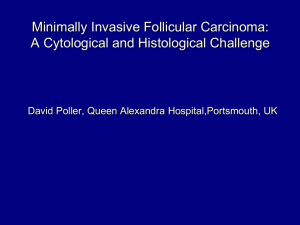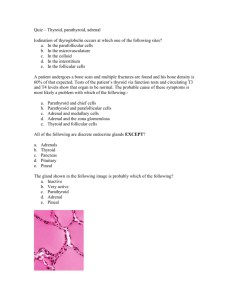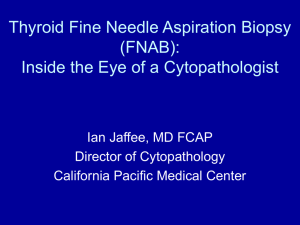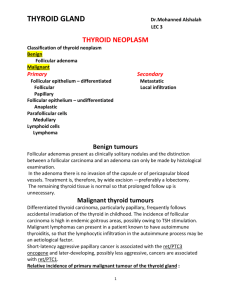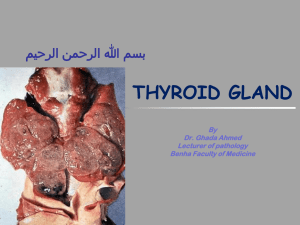Our approach to follicular-patterned lesions of the thyroid VIEWPOINT
advertisement
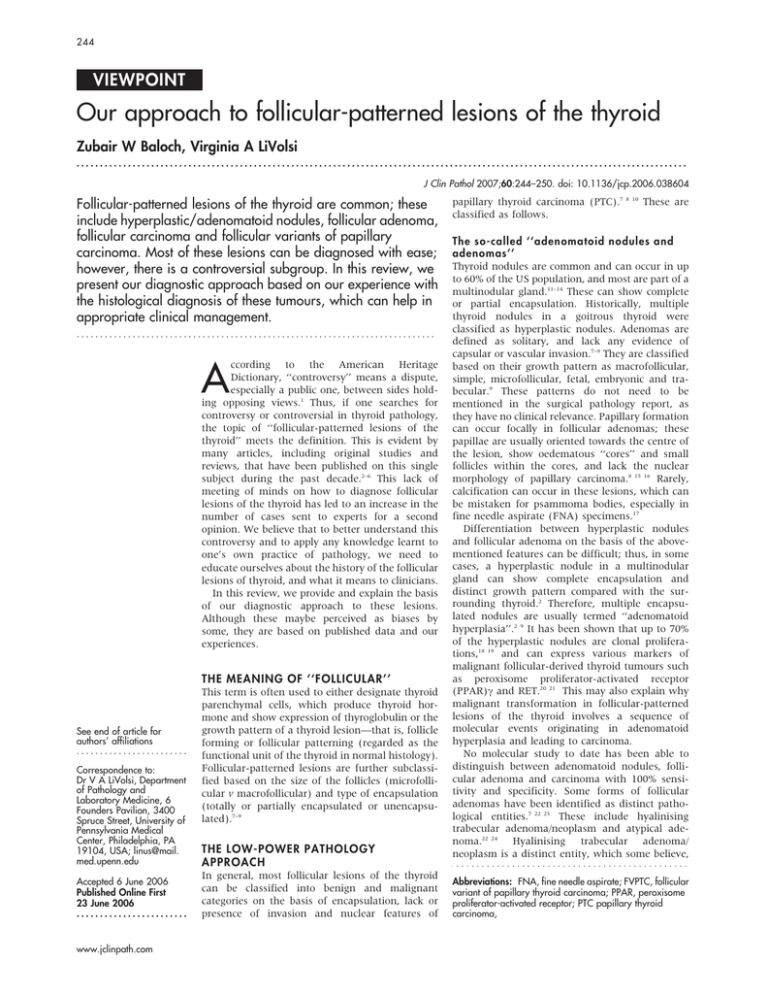
244 VIEWPOINT Our approach to follicular-patterned lesions of the thyroid Zubair W Baloch, Virginia A LiVolsi ................................................................................................................................... J Clin Pathol 2007;60:244–250. doi: 10.1136/jcp.2006.038604 Follicular-patterned lesions of the thyroid are common; these include hyperplastic/adenomatoid nodules, follicular adenoma, follicular carcinoma and follicular variants of papillary carcinoma. Most of these lesions can be diagnosed with ease; however, there is a controversial subgroup. In this review, we present our diagnostic approach based on our experience with the histological diagnosis of these tumours, which can help in appropriate clinical management. ............................................................................. A ccording to the American Heritage Dictionary, ‘‘controversy’’ means a dispute, especially a public one, between sides holding opposing views.1 Thus, if one searches for controversy or controversial in thyroid pathology, the topic of ‘‘follicular-patterned lesions of the thyroid’’ meets the definition. This is evident by many articles, including original studies and reviews, that have been published on this single subject during the past decade.2–6 This lack of meeting of minds on how to diagnose follicular lesions of the thyroid has led to an increase in the number of cases sent to experts for a second opinion. We believe that to better understand this controversy and to apply any knowledge learnt to one’s own practice of pathology, we need to educate ourselves about the history of the follicular lesions of thyroid, and what it means to clinicians. In this review, we provide and explain the basis of our diagnostic approach to these lesions. Although these maybe perceived as biases by some, they are based on published data and our experiences. THE MEANING OF ‘‘FOLLICULAR’’ See end of article for authors’ affiliations ........................ Correspondence to: Dr V A LiVolsi, Department of Pathology and Laboratory Medicine, 6 Founders Pavilion, 3400 Spruce Street, University of Pennsylvania Medical Center, Philadelphia, PA 19104, USA; linus@mail. med.upenn.edu Accepted 6 June 2006 Published Online First 23 June 2006 ........................ www.jclinpath.com This term is often used to either designate thyroid parenchymal cells, which produce thyroid hormone and show expression of thyroglobulin or the growth pattern of a thyroid lesion—that is, follicle forming or follicular patterning (regarded as the functional unit of the thyroid in normal histology). Follicular-patterned lesions are further subclassified based on the size of the follicles (microfollicular v macrofollicular) and type of encapsulation (totally or partially encapsulated or unencapsulated).7–9 THE LOW-POWER PATHOLOGY APPROACH In general, most follicular lesions of the thyroid can be classified into benign and malignant categories on the basis of encapsulation, lack or presence of invasion and nuclear features of papillary thyroid carcinoma (PTC).7 8 10 These are classified as follows. The so-called ‘‘adenomatoid nodules and adenomas’’ Thyroid nodules are common and can occur in up to 60% of the US population, and most are part of a multinodular gland.11–14 These can show complete or partial encapsulation. Historically, multiple thyroid nodules in a goitrous thyroid were classified as hyperplastic nodules. Adenomas are defined as solitary, and lack any evidence of capsular or vascular invasion.7–9 They are classified based on their growth pattern as macrofollicular, simple, microfollicular, fetal, embryonic and trabecular.9 These patterns do not need to be mentioned in the surgical pathology report, as they have no clinical relevance. Papillary formation can occur focally in follicular adenomas; these papillae are usually oriented towards the centre of the lesion, show oedematous ‘‘cores’’ and small follicles within the cores, and lack the nuclear morphology of papillary carcinoma.8 15 16 Rarely, calcification can occur in these lesions, which can be mistaken for psammoma bodies, especially in fine needle aspirate (FNA) specimens.17 Differentiation between hyperplastic nodules and follicular adenoma on the basis of the abovementioned features can be difficult; thus, in some cases, a hyperplastic nodule in a multinodular gland can show complete encapsulation and distinct growth pattern compared with the surrounding thyroid.2 Therefore, multiple encapsulated nodules are usually termed ‘‘adenomatoid hyperplasia’’.2 9 It has been shown that up to 70% of the hyperplastic nodules are clonal proliferations,18 19 and can express various markers of malignant follicular-derived thyroid tumours such as peroxisome proliferator-activated receptor (PPAR)c and RET.20 21 This may also explain why malignant transformation in follicular-patterned lesions of the thyroid involves a sequence of molecular events originating in adenomatoid hyperplasia and leading to carcinoma. No molecular study to date has been able to distinguish between adenomatoid nodules, follicular adenoma and carcinoma with 100% sensitivity and specificity. Some forms of follicular adenomas have been identified as distinct pathological entities.7 22 23 These include hyalinising trabecular adenoma/neoplasm and atypical adenoma.22 24 Hyalinising trabecular adenoma/ neoplasm is a distinct entity, which some believe, Abbreviations: FNA, fine needle aspirate; FVPTC, follicular variant of papillary thyroid carcinoma; PPAR, peroxisome proliferator-activated receptor; PTC papillary thyroid carcinoma, Thyroid neoplasms is a form of encapsulated PTC, based on immunohistochemical and molecular characterisation.24–29 However, recent studies have shown that BRAF mutations, which are specific to papillary carcinoma, do not occur in these lesions.30 31 The term ‘‘atypical follicular adenoma’’ is restricted to a group of encapsulated follicular lesions, which show spontaneous necrosis, infarction, numerous mitoses or unusual cellularity (excluding the unusual cells noted above), and which lack any evidence of capsular or vascular invasion. Follow-up studies have shown that these tumours behave in a benign fashion.22 32–34 The question arises as to why we need to make a distinction between hyperplastic/adenomatoid nodules and adenoma when both are so biologically similar. Until molecular evidence can effectively differentiate between benign and malignant follicular-patterned lesions, we believe that an encapsulated thyroid nodule with a distinct growth pattern compared with the surrounding thyroid can be classified as a follicular adenoma. Follicular carcinoma Follicular carcinoma is a rare (approximately 5% of all thyroid malignancies) form of thyroid cancer in the USA. It is reportedly more prevalent (25–40%) in iodine-deficient regions (it must be remembered that many of the studies of this question are based on PTC criteria used before the definition of the follicular variant was used, hence these data need to be reexamined). It is more common in women and shows a wide age distribution (peaking in the fifth and sixth decades).35–37 Clinically, follicular carcinoma presents as a solitary mass (usually measuring .2 cm) in the thyroid; incidental follicular carcinoma is rare.7 8 37 The sole criterion for the diagnosis of follicular carcinoma is demonstration of capsular or vascular invasion. Therefore, histological examination of the tumour capsule interface is more prudent than examination of central portion of the tumour. Follicular carcinoma does not invade lymphatics; true embolic lymph node metastases are exceedingly rare. Follicular carcinoma disseminates haematogenously and characteristically metastasises to bone, lung, brain and liver.7 8 35 38 The treatment of follicular carcinoma remains controversial. Some consider total thyroidectomy the appropriate treatment for encapsulated follicular cancers for effective radioactive iodine treatment, whereas others believe completion thyroidectomy may represent ‘‘overtreatment’’, as the disease-free interval after lobectomy or cure of these encapsulated lesions is so great.38–42 Total thyroidectomy is the treatment of choice in patients who initially present with metastases.39 42 43 Lymph node dissection is not warranted as these tumours do not spread to nodes; however, abnormal-appearing or enlarged nodes should be sampled. Pathology To date, several articles on the pathological diagnosis of follicular carcinoma have been published; many of these lack reproducibility and long-term clinical follow-up to substantiate the diagnostic approach.35 37 44–48 This is further complicated by the present clinical staging systems, which do not consider the age and sex of patients, as most of these are based on patients with PTC.49–51 Traditionally, follicular carcinoma is classified as so-called widely invasive and minimally invasive.7 8 Widely invasive follicular carcinoma is clinically and surgically recognisable as a cancer; the role of the pathologist in its diagnosis is to confirm that it is of follicular origin. These lesions grossly spread throughout the thyroid and invade the perithyroidal tissues. Such tumours are often fairly cellular, usually microfollicular, or solid or trabecular in pattern and are 245 often classified as poorly differentiated/insular carcinoma. The mortality is high; .50% of patients die of disease.52–56 Minimally invasive follicular carcinoma resembles a follicular adenoma; grossly, the lesion is well defined. Most measure .4 cm.7 47 57 Usually, these tumours have thickened capsules compared with the benign counterpart—that is, follicular adenoma. The pathological diagnosis of minimally invasive follicular carcinoma is made when there is capsular invasion; however, some authors have suggested this terminology also for tumours with invasion of the capsular vessels.35 37 Capsular invasion is usually seen as nests of tumour cells penetrating into the tumour capsule (fig 1). In most cases, there are multiple foci of capsular invasion; rarely, one may encounter only a single focus of capsular invasion in a wellsampled tumour.48 53 58–61 Capsular invasion remains a controversial topic in the diagnosis of follicular carcinoma.2 47 Some experts believe that capsular invasion alone—that is, without vascular invasion—does not warrant a diagnosis of carcinoma. Lang and Franssila et al consider nests of tumour in the capsule to possibly represent trapping and distortion by fibrosis rather than invasion. These authors require penetration of the capsule to diagnose a follicular tumour as carcinoma, preferring not to overdiagnose such lesions.32 35 59 62 Iida63 noted that distinguishing capsular invasion from trapping may prove difficult; he required that the invasive tongues of tumour sever and deflect the collagen fibres in the capsule. Thus, in Iida’s opinion, focal invasion into the capsule or the finding of a few follicles in the capsule without an apparent reactive fibrosis is insufficient to diagnose cancer. Experts who believe that capsular invasion is a criterion of malignancy are further divided on the definition of capsular invasion—that is, tumour penetration into or through the entire thickness of the capsule. Therefore, the question remains: is capsular invasion insufficient for the diagnosis of follicular cancer? What follow-up is available in series in which such lesions are diagnosed as cancer? Kahn and Perzin 48 found that one in seven (14%) patients with only capsular invasion showed metastases. Evans noted that capsular invasion seemed as important as venous invasion if not more so, as three of seven patients with this finding showed metastases. However, in these three patients, metastases were already present at initial diagnosis.44 Thompson et al47 studied 95 patients with minimally invasive follicular carcinoma and concluded that a diagnosis of follicular carcinoma is justified in the presence of only partial or Figure 1 Capsular invasion in follicular carcinoma showing tumour cells invading into but not through the tumour capsule in a hook-like fashion (some pathologists consider this atypical adenoma or tumour of uncertain malignant potential). www.jclinpath.com 246 total capsular invasion without vascular invasion as, rarely some of these tumours can develop recurrent or metastatic disease. Some authors have proposed that encapsulated follicular tumours with capsular ‘‘invasion’’ should be designated as atypical adenomas to indicate a benign clinical course after thyroid lobectomy. However, these reported cases/series lack long-term follow-up.22 59 Encapsulated follicular carcinomas notoriously can present as metastases many years after initial resection. It is important to recognise that the debate about the capsular invasion criterion is similar to looking through crystal ball for predicting prognosis and hence guiding the management. Most pathologists have seen cases of follicular carcinoma presenting initially in metastatic sites; when the primary thyroid tumour is resected, extensive sampling may disclose only capsular invasion.35 To extrapolate from these cases to all follicular tumours confined to the thyroid at diagnosis may not be justified. It is possible that the small group of patients presenting with metastases and primary lesions showing only capsular invasion harbour tumours of a different biological nature or that unknown host factors are operating in these individuals. Our approach is that capsular invasion alone presenting as a single or multiple foci in an encapsulated follicular-patterned lesion is a definite criterion of malignancy, and the tumour does not have to invade through the entire thickness of the capsule to be classified as carcinoma. In our experience, deeper sectioning of these foci in most cases will show the tumour traversing the entire thickness of the capsule. The invading tumour nests should show a connection with the main tumour mass, as free-floating nests of cells in the tumour capsule may represent entrapment due to preoperative FNA or tumour degeneration. Small nodules outside the tumour capsule, which appear similar in morphology to the main tumour mass, should also not be considered as foci of invasion if they fail to show any connection to the tumour. In our practice, we classify encapsulated follicular tumours with only capsular invasion (and if they lack nuclear features of papillary carcinoma) as minimally invasive follicular carcinoma. We strongly believe that these tumours have a low risk of recurrence or metastases. Vascular invasion is defined as the presence of a tumour embolus in the capsular vessels adherent to the vessel wall and the endothelial cells lining its free surface44 47 48 (fig 2). The criterion for vascular invasion applies solely and strictly to vessels in or beyond the capsule, as tumour plugs within capillaries in the substance of the tumour have no apparent diagnostic or prognostic importance. The histological criteria for diagnosis of vascular invasion are defined as follows: 1. The invasive tumour should form a plug or polyp in a subendothelial location; a few cells or nests slightly impinging into a lumen are insufficient evidence for invasion (fig 2). 2. The tumour thrombus is usually covered by endothelium. Tumour cells or small nests strewn freely in a vessel lumen probably represent artefacts. 3. The endothelium-covered tumour thrombus does not have to be attached to the vessel wall to be accepted as invasion. Our approach is that when vascular invasion is found in an encapsulated follicular-patterned lesion without the nuclear features of papillary carcinoma, we use the diagnostic term ‘‘grossly encapsulated angioinvasive follicular carcinoma’’, as this group has a considerable propensity for clinically malignant behaviour. www.jclinpath.com Baloch, LiVolsi Do follicular adenoma and carcinoma represent two extremes of a spectrum? It has been shown that most of the so-called markers of malignancy (in both immunohistochemical and molecular studies) are also expressed in patients diagnosed with hyperplastic/adenomatoid nodules and follicular adenoma.20 64–69 Comparative genomic hybridisation studies have shown that follicular adenomas show genetic aberrations similar to follicular carcinoma. These findings are further supported by cytogenetic karyotyping and allelotyping studies. Among the numerous chromosomal changes described in follicular adenoma and carcinoma, chromosomal loss at 3p25 is most commonly found in both tumours.70–74 Kroll et al 74 described a change involving t(2; 3)(q13; 25) as a fusion of PAX8 (2q13) with PPARG (3p25). Initial studies showed this PAX8–PPARG rearrangement may be specific for follicular carcinoma, as for RET gene rearrangements in PTC. However, later studies showed that this rearrangement was also seen in cases of follicular adenoma.64 Similarly, RAS gene mutations have been described in both follicular adenoma and carcinoma.75 Recently, Barden et al 76 analysed gene expression profiles of follicular adenomas and carcinomas by oligonucleotide array analysis. They found 105 genes differently expressed between adenomas and carcinomas. Of these, six genes showed a relevant differential expression between adenomas and carcinoma. Interestingly, only two cases of minimally invasive follicular carcinoma were included in this study, which showed expression profiles similar to follicular adenomas; all other cases of follicular carcinomas were angioinvasive, including one Hürthle cell carcinoma (considered by many to be biologically different from follicular carcinoma). The aforementioned studies are provocative and challenge the diagnostic approach and management of follicular lesions of the thyroid. Hence, most cases of minimally invasive carcinoma will behave in a benign fashion, and their treatment should be conservative—that is, lobectomy or partial thyroidectomy (if the tumour capsule is well-sampled and angioinvasion is ruled out). FOLLICULAR VARIANT OF PAPILLARY THYROID CARCINOMA This is the second most common variant of papillary carcinoma of thyroid after the classic variety. Follicle formation and nuclear features of papillary carcinoma—that is, nuclear elongation, chromatin clearing, intranuclear grooves and inclusions, eccentric nucleoli and irregular nuclear envelope characterise this tumour77 (figs 3 and 4). Follicular variant of papillary thyroid carcinoma (FVPTC) clinically behaves similarly to classic PTC. This tumour can clinically present either as a single nodule or arise against a background of multinodular goitre. Using light microscopy, some tumours are shown to be completely encapsulated (fig 3), whereas others may show partial to total lack of capsule.77 78 In most instances, the diagnosis of FVPTC is not difficult; this mainly applies to cases that show classic nuclear morphology of papillary carcinoma diffusely distributed throughout the tumour. However, there are cases that show multifocal rather than diffuse distribution of nuclear features of papillary carcinoma. The diagnosis of such lesions as carcinoma is controversial.5 79 80 Some authors have suggested that these cases should not be placed into a definite benign or malignant category and should be termed as ‘‘well-differentiated tumour of uncertain malignant potential’’, thus preventing more surgery and treatment.81 However, recent studies have looked into RET/PTC distribution in cases of FVPTC, which show multiple rather than diffuse foci diagnostic of PTC, and have shown that RET/PTC is expressed in the areas of PTC; this Thyroid neoplasms Figure 2 Vascular invasion in follicular carcinoma showing tumour cells invading a capsular vessel; the invading tumour nest is lined by endothelial cells (inset). confirms the morphological impression that these are indeed multiple foci of PTC.82 When faced with a follicular-patterned encapsulated nodule with multiple foci showing cytological features characteristic of PTC, how should such cases be diagnosed? We believe that we can approach such cases in two ways: count all the foci diagnostic of PTC and report them as multiple foci of micro-PTC arising in a benign nodule, giving their size measurements of each focus, or diagnose the entire nodule as FVPTC. We believe that the first method of diagnosing these lesions will create confusion—that is, whether to perform completion thyroidectomy or not—as some clinicians/surgeons do recommend total thyroidectomy for patients with multiple foci of papillary carcinoma. In our practice, we take the second approach; if an encapsulated follicular-patterned lesion shows multiple foci of PTC intermixed with areas lacking nuclear features of PTC, then, for treatment and staging purposes, we diagnose the entire lesion as FVPTC. In addition, we have studied cases that have been diagnosed as follicular adenoma or tumours of uncertain malignant potential on the basis of minimal nuclear features of PTC and that have later developed lymph node and bone metastases.79 Is FVPTC a hybrid of follicular carcinoma and papillary carcinoma? Although FVPTC is a variant of papillary carcinoma (on the basis of cytology and clinical behaviour), it does share some morphological and clinical features with follicular carcinoma. These include follicular growth pattern, encapsulation, capsular and vascular invasion (fig 4), and distant metastases to lung and bone.10 83 84 This association of FVPTC with follicular carcinoma is further substantiated by genetic studies. Gene expression profiling studies have shown that some cases of FVPTC show profiles similar to follicular carcinoma.76 Comparative genomic hybridisation analyses have shown that the presence and pattern of chromosomal aberration in FVPTC are markedly different from those in classic PTC, being more comparable to follicular adenoma and follicular carcinoma.70 RAS gene mutations, an abnormality seen in follicular adenoma and carcinoma, are exclusively seen in FVPTC and not in classic PTC85–90; similarly, RET gene translocations and BRAF mutations, which are common in classic PTC, are rare in cases of FVPTC.90 91 Therefore, in view of morphological features, clinical behaviour and genetic analysis, it is not unreasonable to hypothesise that cases of FVPTC may 247 Figure 3 A thickly encapsulated follicular-patterned lesion showing nuclear features of papillary carcinoma on high power (inset). represent a hybrid of papillary carcinoma and follicular adenoma or carcinoma. What does this hybrid theory mean? If confirmed, this reclassification would have important prognostic and therapeutic implications. Encapsulated FVPTC without any capsular and vascular invasion (if the tumour is well sampled) will behave like follicular adenomas and those with capsular and vascular invasion as follicular carcinomas. Follicular tumours of uncertain malignant potential In the practice of pathology, it is not uncommon to come across lesions that cannot be categorised as definitely benign or malignant. Such lesions represent a ‘‘grey zone’’ and are usually termed tumours of uncertain or borderline malignant potential. This terminology is well recognised in gynaecological pathology and is applied to epithelial tumours of the ovary and smooth muscle tumours of the uterus. Gynaecologists and oncologists are familiar with these diagnoses and know how to manage their patients on the basis of extensive experience in clinical trials and patient follow-up. Williams et al 81 proposed the term ‘‘follicular tumour of uncertain malignant, potential’’ for follicular-patterned lesions of the thyroid that cannot be readily diagnosed as benign or malignant, either because of minor nuclear changes of PTC or Figure 4 Encapsulated follicular variant showing capsular invasion (arrows); high power, showing nuclear features of papillary carcinoma (inset). www.jclinpath.com 248 Baloch, LiVolsi questionable/minimal capsular invasion. The main reason behind this proposal is to avoid extensive treatment (total thyroidectomy followed by radioactive iodine) of thyroid tumours, which clinically behave in a benign fashion and carry excellent prognosis. This proposal seems to be an attractive resolution for the diagnosis of controversial follicular lesions of thyroid. However, we should not forget that currently there are no clinical follow-up data to justify the use of the term ‘‘follicular tumors of uncertain malignant potential’’ and hence, this diagnosis will generate confusion among clinicians regarding the management of patients. To date, we have not used this terminology in our practice, and we diagnose patients on the basis of diagnostic criteria discussed above. Intraoperative consultation in follicular-patterned lesions of the thyroid Intraoperative consultation is not helpful in the diagnosis of follicular or Hürthle cell carcinomas because the diagnosis of these lesions is dependent on the demonstration of capsular and vascular invasion.92–97 Many sections from the tumour capsule are needed because focal invasion can be missed on a single frozen section as practical issues preclude freezing multiple areas of the nodule. Hence, invasion is not often identified on frozen sections.92 The major problems in frozen section analysis of thyroid nodules include: freezing artefacts that can mimic nuclear features of papillary carcinoma; sampling errors98 99; and, as most of these lesions had undergone preoperative FNA, postFNA changes in the tumour capsule that can be mistaken for capsular or vascular invasion and reactive/reparative nuclear changes that can be mistaken for papillary carcinoma.100 In our experience, intraoperative consultation of thyroid lesions is most beneficial in cases diagnosed as suspicious for papillary carcinoma on FNA. The diagnosis of FVPTC depends on nuclear features and not invasion; in these cases, when intraoperative cytology is combined with frozen sections, >35% of such lesions can be diagnosed as papillary carcinoma. This then leads to definitive surgery as the primary procedure rather than a two-staged surgical procedure.99 101 CONCLUSIONS The topic of follicular-patterned lesions of thyroid is exciting, because we are in the process of learning more about these Take-home messages N N N N N The term adenomatoid hyperplasia is preferable, as hyperplastic nodules in multinodular goitre can show complete encapsulation and a distinct growth pattern compared with the surrounding thyroid. Histological examination of the tumour capsule interface in the diagnosis of follicular carcinoma is more prudent than examination of the central portion of the tumour for excluding capsular or vascular invasion. Follicular carcinoma can be divided into minimally invasive (capsular invasion only) and angioinvasive carcinoma. Some cases of FVPTC can show multifocal rather than diffuse distribution of nuclear features of papillary carcinoma. The diagnosis of such lesions as carcinoma is controversial. Frozen section analysis should only be performed in cases that are diagnosed as ‘‘suspicious for papillary carcinoma’’ on cytological examination. www.jclinpath.com lesions and are finally asking the right biological questions. The answers may seem puzzling because the whole notion of benign versus malignant is not as clear-cut as initially thought. As discussed earlier, some cases of FVPTC and follicular carcinoma share genetic profiles with benign lesions such as follicular adenoma and hyperplastic/adenomatoid nodule. Therefore, are we ready to reclassify the follicular lesions of the thyroid on the basis of these recent molecular data? We believe that these studies need to be reproduced by multiple investigators in larger cohorts of cases with clinical data to propose a new classification of follicular-patterned lesions of the thyroid and change/modify the existing paradigm of clinical management. Until then, we will continue to classify these lesions according to the scheme discussed earlier. ....................... Authors’ affiliations Z W Baloch, V A LiVolsi, Department of Pathology and Laboratory Medicine, University of Pennsylvania Medical Center, Philadelphia, Pennsylvania, USA Competing interests: None declared. REFERENCES 1 Pickett Jea, ed. The American Heritage Dictionary of the English language, 4th edn. Boston: Houghton Mifflin, 2000. 2 Baloch ZW, Livolsi VA. Follicular-patterned lesions of the thyroid: the bane of the pathologist. Am J Clin Pathol 2002;117:143–50. 3 Chan JK. Strict criteria should be applied in the diagnosis of encapsulated follicular variant of papillary thyroid carcinoma. Am J Clin Pathol 2002;117:16–18. 4 Renshaw AA, Gould EW. Why there is tendency to ‘‘overdiagnose’’ the follicular variant of papillary thyroid carcinoma. Am J Clin Pathol 2002;117:19–21. 5 Lloyd RV, Erickson LA, Casey MB, et al. Observer variation in the diagnosis of follicular variant of papillary thyroid carcinoma. Am J Surg Pathol 2004;28:1336–40. 6 Hunt JL, Dacic S, Barnes EL, et al. Encapsulated follicular variant of papillary thyroid carcinoma. Am J Clin Pathol 2002;118:602–3; author reply 605–6. 7 Rosai J, Carcangui ML, DeLellis RA. In: Rosai J, Sobin LE, eds. Tumors of the thyroid gland. Washington, DC: Armed Forces Institute of Pathology, 1992. 8 LiVolsi VA. Surgical pathology of the thyroid. Philadelphia, PA: WB Saunders, 1990. 9 Murray D. In:, Kovacs KaA S, ed. The thyroid gland. Malden, MA: Blackwell Science, 1998:295–380. 10 Baloch Z, LiVolsi VA. In:, Livolsi VA, Asa S, eds. Pathology of the thyroid gland. Philadelphia, PA: Churchill Livingston, 2002:61–88. 11 Maloof F, Wang CA, Vickery AL Jr. Nontoxic goiter-diffuse or nodular. Med Clin North Am 1975;59:1221–32. 12 Ashcraft MW, Van Herle AJ. Management of thyroid nodule: scanning techniques, thyroid suppressive therapy and fine-needle aspiration. Head Neck Surg 1981;3:297–322. 13 Mazzaferri EL. Solitary thyroid nodule. 1. Clinical characteristics. Postgrad Med 1981;70:98–103. 14 Mazzaferri EL. Solitary thyroid nodule. 2. Selective approach to management. Postgrad Med. 1981;70: 107–9, 112, 116). 15 Vickery AL Jr. Thyroid papillary carcinoma. Pathological and philosophical controversies. Am J Surg Pathol 1983;7:797–807. 16 LiVolsi VA. Papillary neoplasms of the thyroid. Pathologic and prognostic features. Am J Clin Pathol 1992;97:426–34. 17 Khurana KK, Baloch ZW, LiVolsi VA. Aspiration cytology of pediatric solitary papillary hyperplastic thyroid nodule. Arch Pathol Lab Med 2001;125:1575–8. 18 Hicks DG, LiVolsi VA, Neidich JA, et al. Clonal analysis of solitary follicular nodules in the thyroid. Am J Pathol 1990;137:553–62. 19 Apel RL, Ezzat S, Bapat BV, et al. Clonality of thyroid nodules in sporadic goiter. Diagnostic Mol Pathol 1995;4:113–21. 20 Gustafson KS, LiVolsi VA, Furth EE, et al. Peroxisome proliferator-activated receptor gamma expression in follicular-patterned thyroid lesions. Caveats for the use of immunohistochemical studies. Am J Clin Pathol 2003;120:175–81. 21 Elisei R, Romei C, Vorontsova T, et al. RET/PTC rearrangements in thyroid nodules: studies in irradiated and not irradiated, malignant and benign thyroid lesions in children and adults. J Clin Endocrinol Metab 2001;86:3211–16. 22 Hazard JB, Kenyon R. Atypical adenoma of the thyroid. Arch Pathol 1954;58:554–63. 23 Satoh Y, Sakamoto A, Hosoya T, et al. Clinico-pathological study of atypical adenomas of the thyroid. Gan No Rinsho. Jpn J Cancer Clin 1987;33:1039–43. 24 Carney JA, Ryan J, Goellner JR. Hyalinizing trabecular adenoma of the thyroid gland. Am J Surg Pathol 1987;11:583–91. Thyroid neoplasms 25 Katoh R, Jasani B, Williams ED. Hyalinizing trabecular adenoma of the thyroid. A report of three cases with immunohistochemical and ultrastructural studies. Histopathology 1989;15:211–24. 26 Hirokawa M, Carney JA, Ohtsuki Y. Hyalinizing trabecular adenoma and papillary carcinoma of the thyroid gland express different cytokeratin patterns. Am J Surg Pathol 2000;24:877–81. 27 Nikiforov YE. RET/PTC rearrangement in thyroid tumors. Endocr Pathol 2002;13:3–16. 28 Cheung CC, Boerner SL, MacMillan CM, et al. Hyalinizing trabecular tumor of the thyroid: a variant of papillary carcinoma proved by molecular genetics. Am J Surg Pathol 2000;24:1622–6. 29 Papotti M, Volante M, Giuliano A, et al. RET/PTC activation in hyalinizing trabecular tumors of the thyroid. Am J Surg Pathol 2000;24:1615–21. 30 Nakamura N, Carney JA, Jin L, et al. RASSF1A and NORE1A methylation and BRAFV600E mutations in thyroid tumors. Lab Invest 2005;85:1065–75. 31 Trovisco V, Vieira de Castro I, Soares P, et al. BRAF mutations are associated with some histological types of papillary thyroid carcinoma. J Pathol 2004;202:247–51. 32 Lang W, Georgii A, Atay Z. Differential diagnosis between atypical adenoma and follicular carcinoma of the thyroid gland (author’s translation). Verh Dtsch Ges Pathol 1977;61:275–9. 33 Adolf W, Widhalm G, Rieger H. The importance of atypical adenoma of the thyroid gland. Zentralbl Allg Pathol 1988;134:719–26. 34 Fukunaga M, Shinozaki N, Endo Y, et al. Atypical adenoma of the thyroid. A clinicopathologic and flow cytometric DNA study in comparison with other follicular neoplasms. Acta Pathol Jpn 1992;42:632–8. 35 Franssila KO, Ackerman LV, Brown CL, et al. Follicular carcinoma. Semin Diagn Pathol 1985;2:101–22. 36 Mazzaferri EL, Massoll N. Management of papillary and follicular (differentiated) thyroid cancer: new paradigms using recombinant human thyrotropin. Endocr Relat Cancer 2002;9:227–47. 37 Meissner WA. Follicular carcinoma of the thyroid; frozen section diagnosis. Am J Surg Pathol 1977;1:171–5. 38 Mazzaferri EL. An overview of the management of papillary and follicular thyroid carcinoma. Thyroid 1999;9:421–7. 39 Cady B, Sedgwick CE, et al. Changing clinical, pathologic, therapeutic and survival patterns in differentiated thyroid carcinoma. Ann Surg 1976;184:541–53. 40 Clark OH, Fredrickson JM, Harvey HK. Thyroid mass. Head Neck 1993;15:574–9. 41 Crile G Jr, Pontius KI, Hawk WA. Factors influencing the survival of patients with follicular carcinoma of the thyroid gland. Surgery, Gynecol Obstetrics 1985;160:409–13. 42 Emerick GT, Duh QY, Siperstein AE, et al. Diagnosis, treatment, and outcome of follicular thyroid carcinoma. Cancer 1993;72:3287–95. 43 Erdem E, Gulcelik MA, Kuru B, et al. Comparison of completion thyroidectomy and primary surgery for differentiated thyroid carcinoma. Eur J Surg Oncol 2003;29:747–9. 44 Evans HL. Follicular neoplasms of the thyroid. A study of 44 cases followed for a minimum of 10 years with emphasis on differential diagnosis. Cancer 1984;54:535–40. 45 LiVolsi VA, Asa SL. The demise of follicular carcinoma of the thyroid gland. Thyroid 1994;4:233–6. 46 Hirokawa M, Carney JA, Goellner JR, et al. Observer variation of encapsulated follicular lesions of the thyroid gland. Am J Surg Pathol 2002;26:1508–14. 47 Thompson LD, Wieneke JA, Paal E, et al. A clinicopathologic study of minimally invasive follicular carcinoma of the thyroid gland with a review of the English literature. Cancer 2001;91:505–24. 48 Kahn NF, Perzin KH. Follicular carcinoma of the thyroid: an evaluation of the histologic criteria used for diagnosis. Pathol Annu 1983;18(Pt 1):221–53. 49 Cady B. Hayes Martin lecture. Our AMES is true: how an old concept still hits the mark, or, risk group assignment points the arrow to rational therapy selection in differentiated thyroid cancer. Am J Surg 1997;174:462–8. 50 Goepfert H, Callender DL. Differentiated thyroid cancer—papillary and follicular carcinomas. Am J Otolaryngol 1994;15:167–79. 51 Cady B, Rossi R. An expanded view of risk-group definition in differentiated thyroid carcinoma. Surgery 1988;104:947–53. 52 Segal K, Arad A, Lubin E, et al. Follicular carcinoma of the thyroid. Head Neck 1994;16:533–8. 53 Zedenius J, Auer G, Backdahl M, et al. Follicular tumors of the thyroid gland: diagnosis, clinical aspects and nuclear DNA analysis. World J Surg 1992;16:589–94. 54 D’Avanzo A, Treseler P, Ituarte PH, et al. Follicular thyroid carcinoma: histology and prognosis. Cancer 2004;100:1123–9. 55 Passler C, Scheuba C, Prager G, et al. Prognostic factors of papillary and follicular thyroid cancer: differences in an iodine-replete endemic goiter region. Endocr Relat Cancer 2004;11:131–9. 56 Collini P, Sampietro G, Rosai J, et al. Minimally invasive (encapsulated) follicular carcinoma of the thyroid gland is the low-risk counterpart of widely invasive follicular carcinoma but not of insular carcinoma. Virchows Arch 2003;442:71–6. 57 LiVolsi VA. Well differentiated thyroid carcinoma. Clin Oncol (R Coll Radiol) 1996;8:281–8. 58 Sprenger E, Lowhagen T, Vogt-Schaden M. Differential diagnosis between follicular adenoma and follicular carcinoma of the thyroid by nuclear DNA determination. Acta Cytol 1977;21:528–30. 59 Lang W, Georgii A, Stauch G, et al. The differentiation of atypical adenomas and encapsulated follicular carcinomas in the thyroid gland. Virchows Arch [A] 1980;385:125–41. 249 60 Galera-Davidson H, Bibbo M, Bartels PH, et al. Differential diagnosis between follicular adenoma and follicular carcinoma of the thyroid by marker features. Anal Quant Cytol Histol 1986;8:195–200. 61 Schmidt RJ, Wang CA. Encapsulated follicular carcinoma of the thyroid: diagnosis, treatment, and results. Surgery 1986;100:1068–77. 62 Lang W, Georgii G. Minimal invasive cancer in the thyroid. Clin Oncol 1982;1:527–37. 63 Iida F. The fate and surgical significance of adenoma of the thyroid gland. Surg Gynecol Obstet 1974;136:536–40. 64 Marques AR, Espadinha C, Catarino AL, et al. Expression of PAX8-PPAR gamma 1 rearrangements in both follicular thyroid carcinomas and adenomas. J Clin Endocrinol Metab 2002;87:3947–52. 65 Nikiforov M, Biddinger P, Caudill CM, et al. PAX8-PPAR c rearrangement in thyroid tumors: RT-PCR and immunohistochemical analysis. Am J Surg Pathol 2002;26:1016–23. 66 Villanueva-Siles E, Tanaka K, Wenig BM. Peroxisome proliferator-activated receptor gamma 1 (PPAR-c1) in benign and malignant thyroid lesions: an immunohistochemical study [abstract]. Mod Pathol 2002;15:121A. 67 Chiappetta G, Tallini G, De Biasio MC, et al. FRA-1 expression in hyperplastic and neoplastic thyroid diseases. Clin Cancer Res 2000;6:4300–6. 68 Namba H, Rubin SA, Fagin JA. Point mutations of ras oncogenes are an early event in thyroid tumorigenesis. Mol Endocrinol 1990;4:1474–9. 69 Nikiforov YE, Nikiforova MN, Gnepp DR, et al. Prevalence of mutations of ras and p53 in benign and malignant thyroid tumors from children exposed to radiation after the Chernobyl nuclear accident. Oncogene 1996;13:687–93. 70 Wreesmann VB, Ghossein RA, Hezel M, et al. Follicular variant of papillary thyroid carcinoma: genome-wide appraisal of a controversial entity. Genes Chromosomes Cancer 2004;40:355–64. 71 Wreesmann VB, Ghossein RA, Patel SG, et al. Genome-wide appraisal of thyroid cancer progression. Am J Pathol 2002;161:1549–56. 72 Wada N, Duh QY, Miura D, et al. Chromosomal aberrations by comparative genomic hybridization in Hurthle cell thyroid carcinomas are associated with tumor recurrence. J Clin Endocrinol Metab 2002;87:4595–601. 73 Roque L, Clode A, Belge G, et al. Follicular thyroid carcinoma: chromosome analysis of 19 cases. Genes Chromosomes Cancer 1998;21:250–5. 74 Kroll TG, Sarraf P, Pecciarini L, et al. PAX8-PPAR[gamma] 1 fusion in oncogene human thyroid carcinoma. Science 2000;289:1357–60. 75 Namba H, Gutman RA, Matsuo K, et al. H-ras protooncogene mutations in human thyroid neoplasms. J Clin Endocrinol Metab 1990;71:223–9. 76 Barden CB, Shister KW, Zhu B, et al. Classification of follicular thyroid tumors by molecular signature: results of gene profiling. Clin Cancer Res 2003;9:1792–800. 77 Chen KTC, Rosai J. Follicular variant of thyroid papillary carcinoma: a clinicopathologic study of six cases. Am J Surg Pathol 1977;1:123–30. 78 Burningham AR, Krishnan J, Davidson BJ, et al. Papillary and follicular variant of papillary carcinoma of the thyroid: initial presentation and response to therapy. Otolaryngol Head Neck Surg 2005;132:840–4. 79 Baloch Z, LiVolsi VA, Henricks WH, et al. Encapsulated follicular variant of papillary thyroid carcinoma. Am J Clin Pathol. 2002;118: 603–5; discussion 605–6). 80 Baloch ZW, Gupta PK, Yu GH, et al. Follicular variant of papillary carcinoma. Cytologic and histologic correlation. Am J Clin Pathol 1999;111:216–22. 81 Williams ED, Abrosimov A, Bogdanova TI, et al. Two proposals regarding the terminology of thyroid tumors. Guest Editorial. Int J Surg Pathol 2000;8:181–3. 82 Fusco A, Chiappetta G, Hui P, et al. Assessment of RET/PTC oncogene activation and clonality in thyroid nodules with incomplete morphological evidence of papillary carcinoma: a search for the early precursors of papillary cancer. Am J Pathol 2002;160:2157–67. 83 Baloch ZW, LiVolsi VA. Encapsulated follicular variant of papillary thyroid carcinoma with bone metastases. Mod Pathol 2000;13:861–5. 84 Carcangui MLZG, Pupi A, Castagnoli A, et al. Papillary carcinoma of the thyroid: a clinico-pathologic study of 241 cases treated at the University of Florence, Italy. Cancer 1985;55:805–28. 85 Carta C, Moretti S, Passeri L, et al. Genotyping of an Italian papillary thyroid carcinoma cohort revealed high prevalence of BRAF mutations, absence of RAS mutations and allowed the detection of a new mutation of BRAF oncoprotein (BRAF(V599lns)). Clin Endocrinol (Oxf) 2006;64:105–9. 86 Kroll TG. Molecular events in follicular thyroid tumors. Cancer Treat Res 2004;122:85–105. 87 Giordano TJ, Kuick R, Thomas DG, et al. Molecular classification of papillary thyroid carcinoma: distinct BRAF, RAS, and RET/PTC mutation-specific gene expression profiles discovered by DNA microarray analysis. Oncogene 2005;24:6646–56. 88 Quiros RM, Ding HG, Gattuso P, et al. Evidence that one subset of anaplastic thyroid carcinomas are derived from papillary carcinomas due to BRAF and p53 mutations. Cancer 2005;103:2261–8. 89 Fukushima T, Suzuki S, Mashiko M, et al. BRAF mutations in papillary carcinomas of the thyroid. Oncogene 2003;22:6455–7. 90 Zhu Z, Gandhi M, Nikiforova MN, et al. Molecular profile and clinicalpathologic features of the follicular variant of papillary thyroid carcinoma. An unusually high prevalence of ras mutations. Am J Clin Pathol 2003;120:71–7. 91 Inaba M, Umemura S, Satoh H, et al. Expression of RET in follicular cell-derived tumors of the thyroid gland: prevalence and implication of morphological type. Pathol Int 2003;53:146–53. 92 Bronner MP HR, LiVolsi VA. Utility of frozen section analysis on follicular lesions of the thyroid. Endocr Pathol 1994;5:154–61. 93 Aguilar-Diosdado M, Contreras A, Gavilan I, et al. Thyroid nodules. Role of fine needle aspiration and intraoperative frozen section examination. Acta Cytol 1997;41:677–82. www.jclinpath.com 250 94 Schmid KW, Ladurner D, Zechmann W, et al. Clinicopathologic management of tumors of the thyroid gland in an endemic goiter area. Combined use of preoperative fine needle aspiration biopsy and intraoperative frozen section. Acta Cytol 1989;33:27–30. 95 Lin HS, Komisar A, Opher E, et al. Surgical management of thyroid masses: assessing the need for frozen section evaluation. Laryngoscope 1999;109:868–73. 96 Udelsman R, Westra WH, Donovan PI, et al. Randomized prospective evaluation of frozen-section analysis for follicular neoplasms of the thyroid. Ann Surg 2001;233:716–22. 97 DeMay RM. Frozen section of thyroid? Just say no. Am J Clin Pathol 1998;110:423–4. www.jclinpath.com Baloch, LiVolsi 98 Basolo F, Baloch ZW, Baldanzi A, et al. Usefulness of ultrafast Papanicolaoustained scrape preparations in intraoperative management of thyroid lesions. Mod Pathol 1999;12:653–7. 99 Paessler M, LiVolsi VA, Baloch Z. Role of ultrafast Papanicolaou stained scrape preparations as an adjunct to frozen section in the surgical management of thyroid lesions. Endocr Pract 2001;7:89–94. 100 Baloch ZW, LiVolsi VA. Post fine-needle aspiration histologic alterations of thyroid revisited. Am J Clin Pathol 1999;112:311–16. 101 Logani S, Gupta PK, LiVolsi VA, et al. Thyroid nodules with FNA cytology suspicious for follicular variant of papillary thyroid carcinoma: follow-up and management. Diagn Cytopathol 2000;23:380–5.
